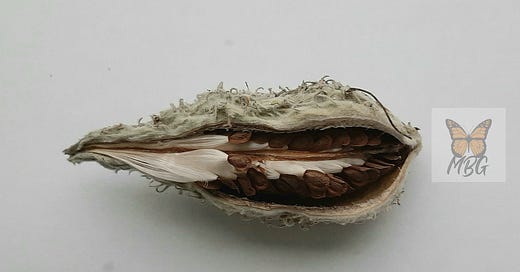If you live in the Midwest and are eager to start a garden to help our Monarchs, consider growing Common Milkweed. Milkweed is the only plant where Monarchs lay their eggs and the only food source for caterpillars. It’s easy to grow and doesn’t need much attention and maintenance.
Late August and September are the best times to harvest seeds. The best way to check if the seeds are ready is to press the seam of the husk with your thumb and then listen for a small pop. If not, wait another week or so. When you look inside the seeds should be a coffee brown. Some people like to wait until the pod is brown and dried with seeds popping out, but it’s harder to avoid the mess of the fluff attached to the seed.
The seeds will be easier to remove while the silky fluff is still tucked inside the pod. Once you remove the husk from the plant after hearing a pop, you can let it dry out for a few days to a week before extracting.
The milk from the milkweed is toxic and can make you or your pets sick if ingested. It might also irritate your skin and eyes. Wear gloves when collecting pods off plants and let husks dry out before seed extraction.
Five Steps to Harvest Common Milkweed Seed
1. Put a piece of newspaper or cardboard on a hard flat surface to catch the seeds.
2. Carefully open the husk over the paper. The fluff and the seeds will be packed together in a bundle. On the thin end of the husk opposite the seeds, grab the ends of the fluff with two fingers and carefully pull out the whole bundle.
3. Use your finger to rake the seeds so they land on the paper or cardboard below.
4. Once you’ve removed the seeds from the fluff, spread them out in a single layer and let them dry for a few days to a week. The leftover fluff can be left outside for the birds to use as nesting material.
5. Store them in a paper envelope or a seed packet envelope. Plastic bags are not ideal as they retain moisture and promote mold growth.
If you find husks popped open with the seeds coming out, you can still remove them without a mess.
Put a sturdy mesh wire over a shallow box. Carefully remove the clump of fluff with seeds from the husk and rub them over the top. The seeds will fall into the box and the fluff will roll into a ball and won’t become airborne.
A sturdy metal mesh baking cooling rack can also do the job. If you go this route, wash it thoroughly afterward or dedicate one for seed extraction to avoid transferring any milky sap on the surfaces where food is prepared.
What a Single Milkweed Plant Can Do for the Environment
A single milkweed plant can produce enough seed to plant your garden with enough left to donate to Monarch conservation organizations. Search online and check with the Department of Natural Resources near you for guidance on what to do next.
Planting seeds is easy. Sow them into the ground before the first frost. The cold winter will improve germination, then they’ll sprout in the spring. Select an area in your yard where the milkweed will get sun all day.
Milkweed plants in your garden will provide a place for Monarchs to sip nectar and lay their eggs. Caterpillars will feed on the leaves then grow and transform into the next generation of beautiful butterflies.





